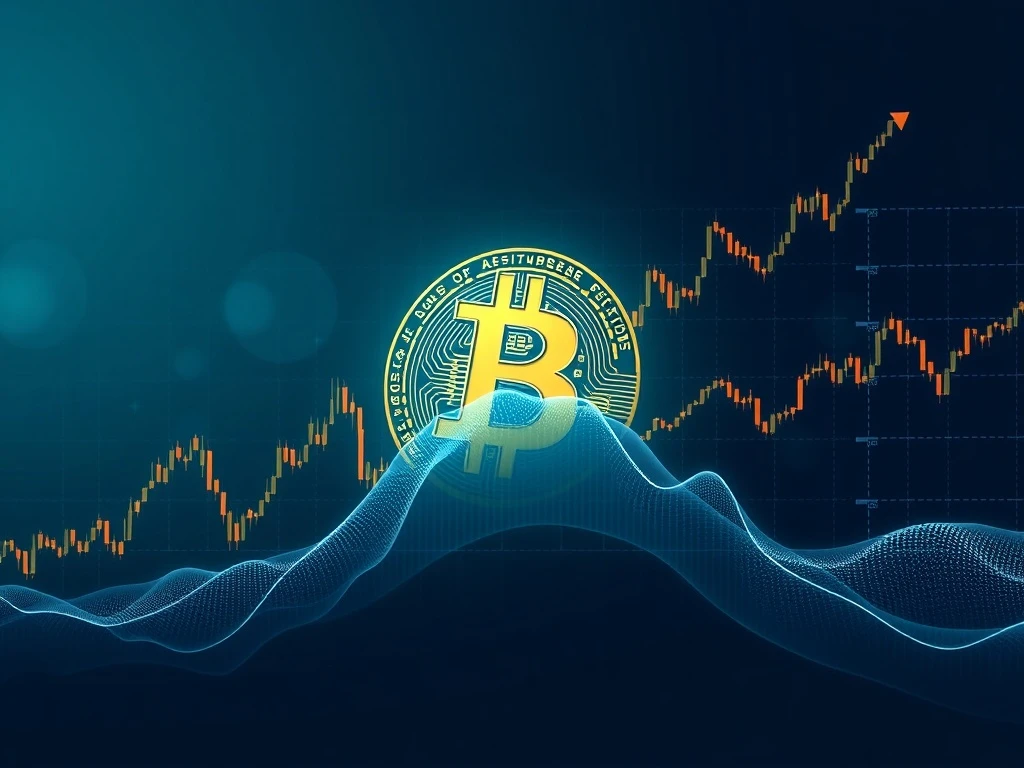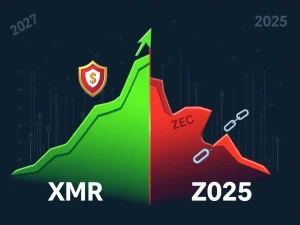Bitcoin VIX Correlation: Unveiling the Profound Shift in Crypto Market Dynamics

The cryptocurrency world is buzzing with a seismic shift: Bitcoin’s volatility, once a law unto itself, is now marching in lockstep with traditional markets. The Bitcoin VIX correlation has hit an unprecedented 0.88, signaling a profound integration that challenges everything we thought we knew about digital assets. This isn’t just a number; it’s a testament to Bitcoin’s evolving role in the global financial landscape, increasingly tethered to the very forces it once sought to escape.
Understanding the Bitcoin VIX Correlation: What Does 0.88 Mean?
For years, Bitcoin was celebrated for its uncorrelated nature, often seen as a hedge against traditional market turmoil. However, recent data paints a different picture. The Bitcoin VIX correlation has surged to an unprecedented high of 0.88. But what does this figure truly represent?
- The VIX Explained: Often dubbed Wall Street’s “fear gauge,” the VIX (Volatility Index) measures the market’s expectation of stock market volatility over the next 30 days, derived from S&P 500 index options. A high VIX indicates investor fear and expected market turbulence.
- Bitcoin’s Implied Volatility: Similar to the VIX, Bitcoin’s implied volatility is a forward-looking metric, calculated from its 30-day implied volatility indices (like Deribit and Volmex). It reflects how much volatility traders expect Bitcoin to experience.
- The 0.88 Significance: This figure, derived from 90-day data, signifies a near lockstep movement between Bitcoin’s expected volatility and that of the S&P 500. Historically, such a high correlation was rare, underscoring a pivotal convergence between crypto and equity markets. It means that when traditional markets brace for volatility, Bitcoin’s volatility is now highly likely to follow suit.
This development fundamentally challenges the historical perception of Bitcoin as a completely decoupled asset. It suggests that the factors influencing traditional market sentiment are now significantly impacting Bitcoin’s price swings.
The Rise of Institutional Crypto Adoption: Driving Bitcoin Market Integration
So, what’s behind this dramatic shift? Experts like Markus Thielen, founder of 10x Research, attribute this convergence primarily to the growing influence of institutional crypto adoption. These aren’t just retail investors anymore; we’re talking about sophisticated players who bring traditional finance strategies to the crypto arena.
- Who Are These Institutions? Think hedge funds, pension funds, sovereign wealth entities, and large asset managers. Their participation injects significant capital and new trading methodologies into the crypto ecosystem.
- Strategic Trading: These institutions aren’t just buying and holding. They’re adopting complex strategies common in traditional markets, such as volatility selling and arbitrage. By selling Bitcoin options, they aim to profit from periods of stability, which in turn can suppress Bitcoin’s implied volatility. This active management by large players naturally tethers Bitcoin’s behavior to broader market trends.
- Regulated Products as Catalysts: The introduction of regulated products, particularly spot Bitcoin ETFs, has been a game-changer. These ETFs provide a familiar, accessible, and regulated pathway for traditional investors to gain exposure to Bitcoin. The increased liquidity from these products also fosters more robust arbitrage opportunities between crypto and traditional financial markets, further solidifying Bitcoin market integration.
The influx of institutional capital and sophisticated trading strategies is effectively maturing the Bitcoin market, making its movements more predictable in relation to macroeconomic indicators, much like other established asset classes.
Navigating Evolving Crypto Market Dynamics: Implications for Investors
This profound shift in crypto market dynamics has significant implications for both institutional and retail investors. Bitcoin’s once-reliable role as a safe-haven asset or a portfolio diversifier is now under intense scrutiny.
Challenges to Consider:
- Reduced Diversification: A high correlation with the VIX means Bitcoin’s volatility is now more likely to spike during periods of traditional market stress, such as geopolitical tensions, central bank policy shifts, or economic downturns. This reduces its effectiveness as a standalone hedge against equity market downturns.
- Synchronized Downturns: Portfolios once diversified with Bitcoin may now face synchronized downturns during market-wide turbulence, potentially negating the perceived benefit of holding crypto for risk mitigation.
Opportunities to Seize:
- Enhanced Liquidity: Institutional involvement brings deeper liquidity to the market, making it easier to enter and exit positions without significant price impact.
- Innovative Financial Products: The integration fosters the development of more sophisticated financial products like futures, options, and structured notes, offering new ways to manage risk and generate returns.
- Arbitrage Strategies: For astute traders, the increasing intertwining of crypto and traditional finance creates more arbitrage opportunities, allowing them to profit from price discrepancies across different markets.
- Regulatory Favorability: As Bitcoin’s market behavior aligns with established norms, regulators and traditional financial players are likely to view it more favorably, potentially accelerating mainstream adoption and opening doors for even wider institutional participation.
For investors, this demands a critical recalibration of risk management strategies. Understanding these new dynamics is crucial for optimizing portfolio performance in an increasingly interconnected financial world.
Managing Bitcoin Volatility in a New Era: Strategies for Success
While the record Bitcoin VIX correlation signals a new era of predictability, it does not eliminate Bitcoin volatility entirely. Rather, it reframes how that volatility behaves in relation to the broader financial ecosystem. Bitcoin remains subject to its own unique dynamics, including:
- Regulatory Developments: New laws and regulations can still trigger significant price swings.
- Technological Advancements: Updates or breakthroughs in blockchain technology, or even issues with network security, can impact market sentiment.
- Macroeconomic Shocks: While its correlation with VIX is high, unprecedented global events can still cause unique reactions in the crypto market.
The key takeaway is that Bitcoin’s volatility is now more predictable in relation to macroeconomic indicators. For investors, this means:
- Informed Risk Assessment: Investors can better anticipate periods of heightened Bitcoin volatility by monitoring traditional market fear gauges and macroeconomic trends.
- Sophisticated Hedging: The availability of more financial products allows for more nuanced hedging strategies to mitigate volatility risks.
- Long-Term Perspective: Despite short-term fluctuations, Bitcoin’s maturation into a sophisticated asset class suggests a more stable, albeit still dynamic, long-term trajectory.
The record correlation highlights a maturing market where Bitcoin’s role is redefined—not as a pure outlier, but as a sophisticated asset with both risks and opportunities tied to global macroeconomic forces.
Conclusion: Bitcoin’s Evolving Identity
The surge in Bitcoin VIX correlation to an unprecedented 0.88 marks a definitive turning point for the world’s leading cryptocurrency. Driven by substantial institutional crypto adoption, Bitcoin is no longer an isolated digital frontier but an increasingly integral component of mainstream finance. This profound Bitcoin market integration reshapes crypto market dynamics, challenging traditional notions of diversification while simultaneously unlocking new avenues for liquidity, innovation, and strategic investment. While Bitcoin volatility will persist, its behavior is now more aligned with established financial benchmarks, offering a clearer lens through which investors can assess risk and opportunity. As Bitcoin continues to evolve, understanding its intricate dance with global markets will be paramount for anyone navigating the future of finance.
Frequently Asked Questions (FAQs)
1. What does a 0.88 Bitcoin VIX correlation truly signify?
A 0.88 Bitcoin VIX correlation means that Bitcoin’s implied volatility (how much its price is expected to fluctuate) moves in near lockstep with the S&P 500’s VIX index, often called the ‘fear gauge’ of Wall Street. This indicates a strong convergence, suggesting that Bitcoin’s price swings are increasingly influenced by the same factors driving volatility in traditional stock markets.
2. How are institutional investors influencing Bitcoin’s market behavior?
Institutional investors, such as hedge funds and pension funds, are bringing sophisticated strategies like volatility selling and arbitrage from traditional finance into the crypto market. By engaging in these activities, they are helping to suppress Bitcoin’s implied volatility and tether its price movements more closely to broader macroeconomic trends, driving significant Bitcoin market integration.
3. Does this high correlation mean Bitcoin is no longer a diversifier?
The high correlation with the VIX suggests that Bitcoin’s effectiveness as a standalone diversifier against traditional market downturns is under scrutiny. During periods of traditional market stress, Bitcoin’s volatility is now more likely to spike, potentially leading to synchronized downturns in diversified portfolios. However, it still offers diversification benefits against other unique risks.
4. What opportunities arise from Bitcoin’s integration with mainstream finance?
This integration brings several opportunities, including enhanced market liquidity, the development of innovative financial products (like more advanced futures and structured notes), and increased arbitrage opportunities between crypto and traditional markets. It also makes Bitcoin more appealing to regulators, potentially accelerating its broader mainstream adoption.
5. How should investors adjust their strategies given this shift in crypto market dynamics?
Investors should recalibrate their risk management strategies by acknowledging Bitcoin’s increased correlation with traditional markets. This may involve reassessing portfolio diversification, utilizing new financial products for hedging, and closely monitoring macroeconomic indicators alongside crypto-specific news to anticipate Bitcoin volatility.
6. Will Bitcoin still experience high volatility despite this integration?
Yes, Bitcoin will still experience volatility. While its volatility is now more predictable in relation to the VIX and macroeconomic indicators, it remains subject to its own unique dynamics, including regulatory changes, technological advancements, and specific supply/demand shifts within the crypto ecosystem. The integration means its volatility is more understandable within a broader financial context, not eliminated.










